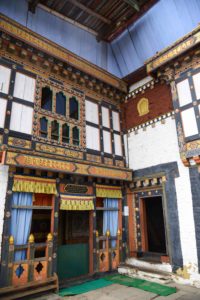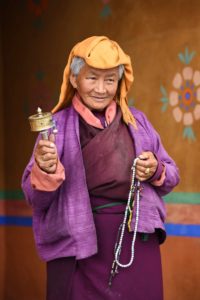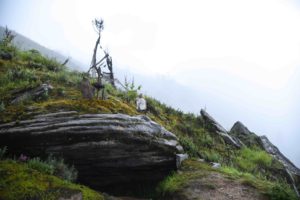Tharpaling Monastery: The Land of Liberation
Latitude: 27.532422; Longitude: 90.688203
Tharpaling Monastery, otherwise known as “The Land of Liberation”, is a beautiful and unique monastery situated on a mountain overlooking Chumey Valley in Bumthang, Bhutan. Its mythic and historic founding is as intricate and interesting as the building’s appearance itself; the monastery harmoniously balances past and the present materials, masculine and feminine function, and the social role of master and disciple. To fully appreciate the monastery’s mythic founding, it is important to establish the history of the legendary founder, Longchenpa.
Longchenpa was born in 1308 in Tibet and is a reincarnation of Princess Pemasel, who was brought back to life by Padmasambhava to receive the initial “Seminal Heart of the Dakinis” teachings. Her next reincarnation was in the form of Tsultrim Dorje who died suddenly and was unable to complete the Seminal Heart teachings. Longchenpa was the third and arguably the most active incarnation of Pema Ledreltsel (the name given to Princess Pemasel by Padmasambhava). Already in this narrative there is an interesting dialogue between gender and age: Pema Ledreltsel was just eight years old when she died, yet despite her young age and historically subordinate gender, her lineage is primarily men who age past ten years old and are successful in their Buddhist teachings. In this way, masculine and feminine roles are equalized early on in the story, setting the stage for a progressive storyline. As Longchenpa learned about the Seminal Heart teachings, he kept a group of Yoginis (female yogis) as disciples. Goddesses sporadically possessed his disciples to transmit teachings and warnings to him, drastically altering the perceived role between the master and the disciple (as well as showing women controlling men), again showing a bold and innovative social diversion between the cultural standard of the time and Longchenpa’s story. Longchenpa cultivated his self confidence and accepted his official role as a treasure revealer and direct descendant of Pema Ledreltsel, establishing himself as an important figure in Buddhist history.
Later in his life, Longchenpa became a teacher in the Gompa Kunrig of Drikung. At the time, this was the most powerful rival to the king of Tibet, Tai Situ. Because of Longchenpa’s association with the school, there was an assassination attempt on his life. Luckily, he used his powers to become invisible and escaped. After this altercation, he went into self-exile in Bhutan, settling on Samling village in the Bumthang district. There, he built the most important section of Tharpaling Monastery, a site that began construction under Lorepa who founded the monastery in the thirteenth century after Guru Rinpoche consecrated the site in 746. Guru Rinpoche was said to have meditated in that spot after he flew from Paro Taktsang on a tigress. Allegedly, “the foot prints of both Guru Rinpoche and the tigress can be found on a rock, as if left in mud.” Much like Longchenpa himself, Tharpaling Monastery has a rich and endearing history that comes from a lineage of mythic Buddhist masters. Lorepa, the original founder, was of the Drukpa school (a branch of the Kagyu school). Longchenpa, the most notable contributor to the monastery, was of the Nyingma school, thus allowing “the place to later become a choice for many Nyingma and Kargyu scholars to spent retreat.” In this way, Tharpaling Monastery encapsulates the scars and strengths of its founder, Longchenpa: he defied masculine/feminine and master/disciple roles in his origination story and was exiled from his home because of his particular Buddhist affiliation; thus, Tharpaling Monastery became his sanctuary, known throughout Bhutan for its unique approach of welcoming different forms of Buddhism. The operative idea of the monastery is acceptance, cementing Tharpaling Monastery as a personified structure of one of the most beloved treasure revealers of the 1300s.
Tharpaling Monastery is an incredibly auspicious site for Bhuddists across Bhutan. It allegedly earned its nickname “The Land of Liberation” when thousands of people came to Tharpaling to meditate and hear Longchenpa’s teachings. Hundreds of monks gained enlightenment that day, and so today Longchenpa’s statue inside Tharpaling Monastery is painted with his eyes lifted towards the sky, watching his enlightened disciples. Even Tibetan Buddhists would venture through Bhutan to hear Longchenpa’s teachings. This shows incredible acclaim for Longchenpa’s reputation considering he exiled himself from Tibet years earlier.
Historically, the monastery was first founded by Lorepa (1187–1250) and finalized by Longchenpa during the 1350s. It was restored by the first king of Bhutan, Ugyen, in the early twentieth century, and became a popular site for Nyingma teachings. Jangchub Choeling Shedra, a monastic school, was established above the monastery in the 1980s. Higher up the mountain still is Chodrak Monastery where Longchenpa was said to have meditated for three years, three months, three weeks, and three days. He also wrote the Seven Treasures, his most well known work which “encapsulates the previous 600 years of Buddhist thought in Tibet”, on a rock throne (pictured below) at the top of a mountain. Perhaps because Longchenpa spent the majority of his life traveling or in retreat, the monasteries he established held a great connection to the physical place. Tharpaling Monstary’s sanctification transcends the building’s grounds and seems to maintain the entire mountain in its sacredness. Cleary, Tharpaling is more than the sum of its physical parts.
Today, visitors can still experience the venerated character of the monastery. Norzang Choda, a tour guide from Thimphu, had never been to Tharpaling Monastery and explained how he felt as though he had cleansed his sins. He had heard about this temple from many people across Bhutan that it was an incredibly beautiful and sacred monastery. From the perspective of a foreigner that did not have a close affiliation to Buddhism, the physical beauty of the monastery alone was a religious experience of sorts. Colorful images cover the inside of the temple while gorgeous and ornate ritual cakes stand before a giant statue of Guru Rinpoche. Modern materials and colors depict historical stories and figures, again, like the social roles in Longchenpa’s life, allowing seemingly polarized topics to exist in harmony. In this way, Tharpaling Monastery is historical, spiritual, and seriously stunning— it appeals to every kind of visitor and is truly timeless.
Bibliography
“THARPALING MONASTERY”. Chungtulkurinpoche.Blogspot.Com, 2018, http://chungtulkurinpoche.blogspot.com/p/about-tharpaling-monastery.html. Accessed 7 Aug 2018.
“Tharpaling Monastery, Bumthang Bhutan”. Windhorsetours.Com, 2018, https://www.windhorsetours.com/sights/bhutan/Tharpaling.html. Accessed 7 Aug 2018.
Martin, Dan. “Lorepa Wangchuk Tsondru”. The Treasury Of Lives, 2008, https://treasuryoflives.org/biographies/view/Lorepa/TBRC_P4252. Accessed 7 Aug 2018.
Penjore, Dorji. “Oral Construction Of Exile Life And Times Of Künkhyen Longchen Rabjam In Bumthang”. Journal Of Bhutan Studies, 2018, http://himalaya.socanth.cam.ac.uk/collections/journals/jbs/pdf/JBS_13_03.pdf. Accessed 7 Aug 2018.
White, David Gordon. Tantra In Practice. pp. 242-265.
http://places.kmaps.virginia.edu/features/69953

Entrance to the temple

Nun outside the temple

The cave where Longchenpa was said to have meditated for three years, three months, three weeks, and three days.
Finley Stewart